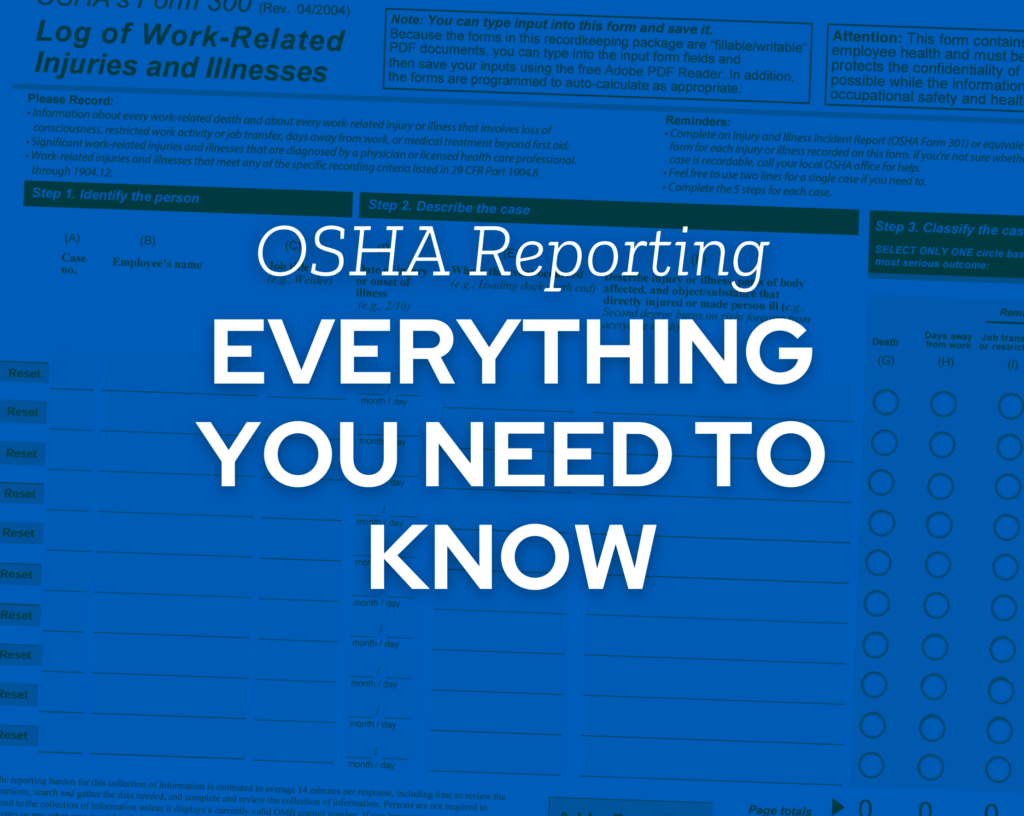When someone is killed or seriously injured in the workplace, the incident must be reported to the Occupational Health and Safety Administration.
Most employers know this. And yet OSHA reporting requirements are sometimes ignored as other, more urgent matters take precedence. In the immediate aftermath of a workplace safety or health incident, rarely is anyone’s first thought, “we need to report this to OSHA.” Reporting, along with recordkeeping, can seem like an unimportant step or unnecessary paperwork—and get delayed or overlooked entirely as a result.
This is a grievous and costly mistake. If you don’t record and report incidents to OSHA on time, you could face significant expenses and penalties. The minimum fine for a single late or missing report is $5,000.
Moreover, if you neglect your OSHA reporting and recordkeeping duties, you put your workforce and bottom line at risk. Reporting to OSHA keeps your organization in compliance and gives you the information and visibility you need to improve workplace safety and minimize incidents.
Here’s what you need to know about OSHA reporting and OSHA recordkeeping: including what needs to be reported, the difference between OSHA reportable and OSHA recordable, exemptions from reporting and recordkeeping, and more.
Read up on all of the deadlines and best practices in the
OSHA Reporting Resource Hub
What Are OSHA’s Reporting Requirements?
Employers with more than ten employees in most industries are required to keep records of occupational injuries and illnesses at their establishments. These records include…
- OSHA 300: Log of work-related injuries and illnesses
- OSHA 300A: Summary of work-related injuries and illnesses
- OSHA 301: Injury and illness incident report
The OSHA electronic reporting rule
OSHA’s reporting requirements have recently changed and now entail electronic reporting. Establishments with 250 or more employees that are currently required to keep OSHA injury and illness records, as well as establishments with 20–249 employees that are classified in certain industries with historically high rates of occupational injuries and illnesses, must electronically submit some information on an annual basis to OSHA. Moreover, organizations in regulated industries must submit 300A forms through OSHA’s Injury Tracking Application.
OSHA Reporting – Key Dates:
February 1: Workplace Posting Deadline
According to OSHA, “Each February through April, employers must post a summary of the injuries and illnesses recorded the previous year. Also, if requested, copies of the records must be provided to current and former employees, or their representatives. It must be posted in a location that is clearly visible to all employees and new applicants, and it must be kept posted until April 30. In addition, employees have the right to request a copy of the records at any time.”
March 2: Form 300A Data Electronic Submission Deadline
Submitted through the Injury Tracking Application. You don’t have to wait until the 2nd to submit your data. Collection begins on January 2nd.
Have more questions? We’ve got lots of answers…
Not every injury or illness needs to be recorded and reported to OSHA. To be considered recordable, an injury or illness must be work-related and require medical attention beyond first aid.
We dive into this topic in this great article: https://www.kpa.io/blog/how-to-record-and-report-workplace-injuries-and-illnesses-to-osha-in-3-steps
How well do you know your Occupational Health and Safety Administration reporting requirements? Can you name the differences between Form 301, Form 300, and Form 300A? How about the timelines for submitting each document to OSHA?
If regulatory paperwork makes your head spin, have no fear—the workforce safety and compliance professionals at KPA are here to help.
Check out this helpful article:
https://www.kpa.io/blog/the-fundamentals-of-osha-recordkeeping
And here’s a step by step on how to fill out your OSHA 300A
We hope you never have to refer to this post EVER. But let’s face it; we work in an industry filled with sharp objects, noxious chemicals, heavy machinery, and distracted workers. For all the hard work you’re doing to build up that safety culture within your organization, keep these OSHA injury reporting timelines in your back pocket just in case something falls through the cracks.
https://www.kpa.io/blog/when-should-i-report-an-injury-to-osha-flowchart
Even if you aren’t required to keep records, there are plenty of reasons to do it. Consider the following benefits:
https://www.kpa.io/blog/osha-recordkeeping-do-you-really-need-to-do-it
Don’t let OSHA recordkeeping requirements take more time and energy than necessary.
KPA makes OSHA electronic reporting—and all elements of OSHA compliance and workforce health and safety—as easy as possible. Complete and file OSHA Forms 301, 300, and 300A quickly and accurately with KPA EHS Software.
Learn how we can save you time and money. Take a Test Drive >>

